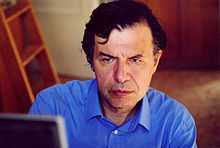Giorgio Parisi
| Giorgio Parisi | |
|---|---|
 Giorgio Parisi | |
| Born |
August 4, 1948 Rome, Italy |
| Residence | Rome, Italy |
| Nationality | Italian |
| Fields | physicist |
| Institutions | Sapienza Università di Roma |
| Alma mater | Sapienza Università di Roma |
| Notable students | Enzo Marinari, Roberto Benzi, Guido Martinelli, Francesco Fucito, Zhang Yi-Cheng, Massimo Bernaschi, Raffaella Burioni, Giulia Iori, Romeo Brunetti, Federico Ricci-Tersenghi, Andrea Cavagna, Irene Giardina, Francesco Zamponi |
| Known for | statistical mechanics, quantum field theory, spin glass, disordered systems, complexity |
| Notable awards | Boltzmann Medal, Dirac Medal, Enrico Fermi Award, Microsoft Award, Lagrange Prize, Max Planck Medal |
Giorgio Parisi (born August 4, 1948) is an Italian theoretical physicist. He is best known for his works concerning statistical mechanics, quantum field theory and various aspects of physics, mathematics and science in general.
Giorgio Parisi's research focused mainly on disordered systems, in particular on spin glass modelling. He also found many applications of spin glass theory to optimization theory, Biology and Immunology. Giorgio Parisi has been awarded several honors; the Boltzmann Medal and the Dirac Medal. He is one of the two Italian physicists to be member of the American National Academy of Sciences.
Giorgio Parisi is one of the top-rated physicists on the h-index standing.[citation needed]
Biography
Giorgio Parisi graduated in University of Rome La Sapienza in 1970, supervised by Nicola Cabibbo. He became a researcher at the Laboratori Nazionali di Frascati (1971–1981) while visiting Columbia University in New York (1973–1974), the Institut des Hautes Études Scientifiques (1976–1977), and the École Normale Supérieure (1977–1978). He got Professor ordinarius position in 1981 at University of Rome Tor Vergata, and in 1992 at University of Rome La Sapienza, where he actually teaches "Statistical mechanics and critical phenomena".
Awards
- Boltzmann Medal, 1992. The motivations for the Boltzmann Medal read:
- Giorgio Parisi, Professor at the University of Rome, is a theoretical physicist of exceptional depth and scope. He has contributed at the highest level to particle physics, computer science, fluid mechanics, theoretical immunology, etc. etc. Today we honor him for his outstanding contributions to statistical physics, and particularly to the theories of phase transitions and of disordered systems. Among these many contributions, I would specifically mention Parisi's early work in which he showed how conformal invariance can be used in a quantitative way to calculate critical exponents. He was also the first to really understand that one can derive critical exponents through expansions of the beta function at fixed dimensions, avoiding the convergence problems of the epsilon-expansion. The opened the way to the current best theoretical estimates of exponents. Another important achievement concerns the mapping of the branched polymer problem in d-dimensions onto that of the Lee-Yang edge singularity on d-2 dimensions. Most recently, Parisi's work on interfaces in disordered media and on the dynamics of growing interfaces has had a large impact on these fields. However, Parisi's deepest contribution concerns the solution of the Sherrington-Kirkpatrick mean field model for spin glasses. After the crisis caused by the unacceptable properties of the simple solutions, which used the "replication trick", Parisi proposed his replica symmetry breaking solution, which seems to be exact, although much more complex than anticipated. Later, Parisi and co-workers Mezard and Virasoro clarified greatly the physical meaning of the mysterious mathematics involved in this scheme, in terms of the probability distribution of overlaps and the ultrametric structure of the configuration space. This achievement forms one of the most important breakthroughs in the history of disordered systems. This discovery opened the doors to vast areas of application. e.g., in optimization problems and in neural network theories.
The Boltzmann Medal for 1992 is hereby awarded to Giorgio Parisi for his fundamental contributions to statistical physics, and particularly for his solution of the mean field theory of spin glasses.
- Dirac Medal and Prize, 1999. The motivations for the Dirac Medal are:
- Giorgio Parisi is distinguished for his original and deep contributions to many areas of physics ranging from the study of scaling violations in deep inelastic processes (Altarelli-Parisi equations), the proposal of the superconductor's flux confinement model as a mechanism for quark confinement, the use of supersymmetry in statistical classical systems, the introduction of multifractals in turbulence, the stochastic differential equation for growth models for random aggregation (the Kardar-Parisi-Zhang model) and his groundbreaking analysis of the replica method that has permitted an important breakthrough in our understanding of glassy systems and has proved to be instrumental in the whole subject of Disordered Systems.
- Enrico Fermi Award, 2002.
- Microsoft Award, 2007. The motivations for the Microsoft Award read:
- He has made outstanding contributions to elementary particle physics, quantum field theory and statistical mechanics, in particular to the theory of phase transitions and replica symmetry breaking for spin glasses. His approach of using computers to corroborate the conclusions of analytical proofs and to actively motivate further research has been of fundamental importance in his field.
- Lagrange Prize, 2009. Awarded to scientists who have contributed most to the development of the science of complexity in various areas of knowledge.
- Max Planck Medal, 2011. The Max Planck medal is an award for extraordinary achievements in theoretical physics. It is awarded annually by the Deutsche Physikalische Gesellschaft.
References
- Bonolis, Luisa; Maria Grazia Melchionni, Carlo Bernardini (2003). Fisici italiani del tempo presente : storie di vita e di pensiero (in Italian). Venezia: Marsilio. ISBN 88-317-8228-2.
- Mezard, Marc; Giorgio Parisi, Miguel Angel Virasoro (1987). Spin glass theory and beyond. Singapore: World Scientific. ISBN 9971-5-0115-5.
- Parisi, Giorgio (2006). La chiave, la luce, l'ubriaco. Roma: Di Renzo Editore. ISBN 88-8323-149-X.
- Parisi, Giorgio; Auletta Gennaro, Fortunato Mauro, (2009). Quantum Mechanics. Cambridge University Press. ISBN 978-0-521-86963-8.
External links
|